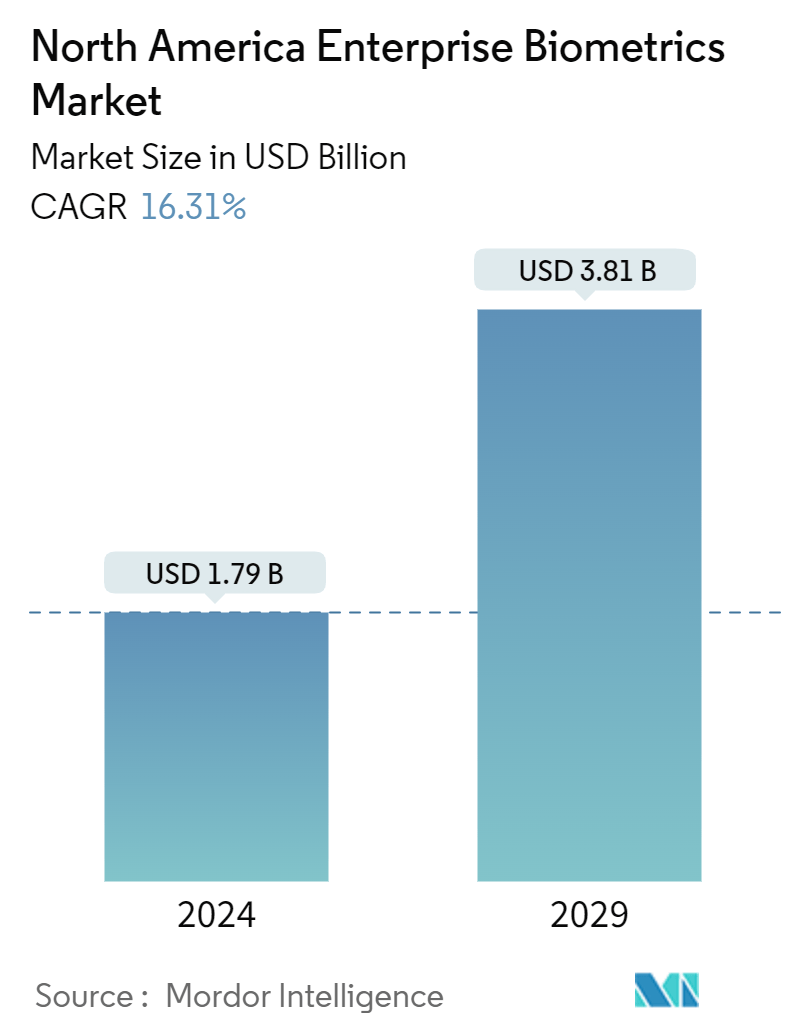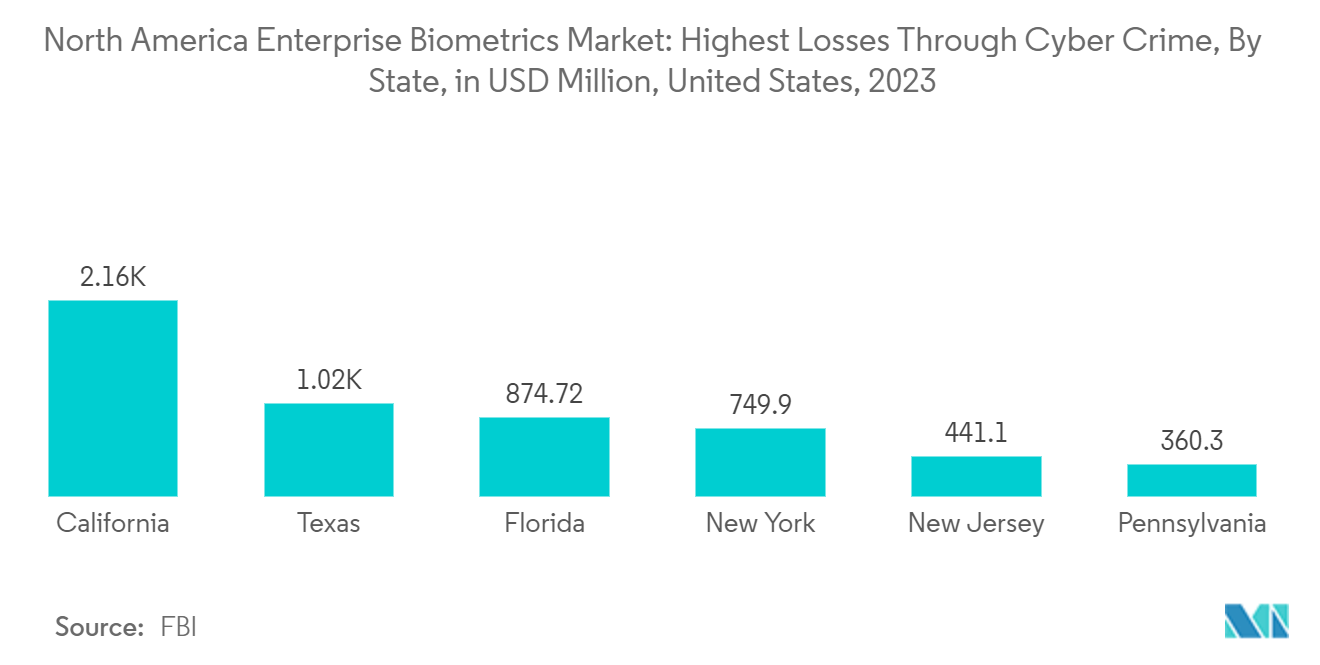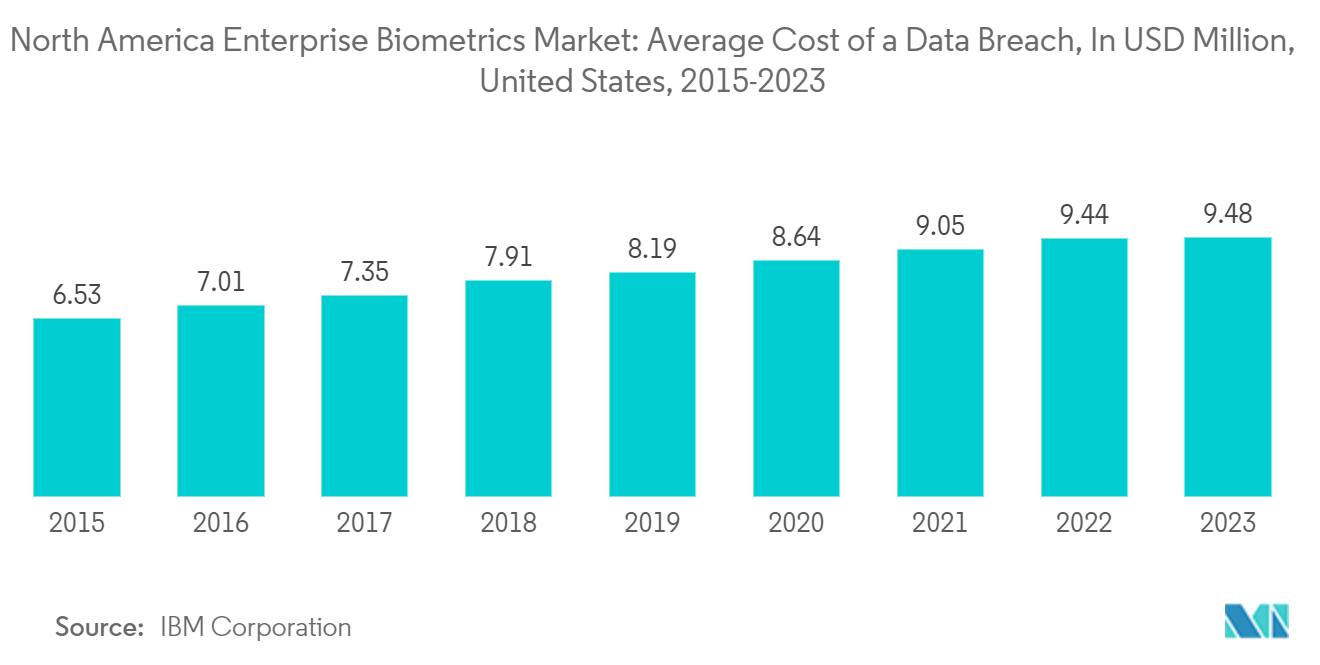North America Enterprise Biometrics Market Size

| Study Period | 2018 - 2029 |
| Base Year For Estimation | 2023 |
| Market Size (2024) | USD 1.79 Billion |
| Market Size (2029) | USD 3.81 Billion |
| CAGR (2024 - 2029) | 16.31 % |
| Market Concentration | Low |
Major Players
*Disclaimer: Major Players sorted in no particular order |
North America Enterprise Biometrics Market Analysis
The North America Enterprise Biometrics Market size is estimated at USD 1.79 billion in 2024, and is expected to reach USD 3.81 billion by 2029, growing at a CAGR of 16.31% during the forecast period (2024-2029).
- Enterprise biometrics refers to the use of biometric authentication technology in the context of business and organizational security. Biometrics involves the usage of unique physical or behavioral characteristics, such as fingerprints, facial features, voice patterns, or iris scans, to verify the identity of individuals. In the enterprise setting, biometric authentication enhances security measures and provides a more convenient and secure way for employees to access systems, applications, and sensitive data. The rising expansion of commercial spaces and demand for high-tech office spaces are anticipated to increase the demand for biometrics in Europe's enterprise sector.
- One of the primary advantages of enterprise biometrics is its ability to provide heightened security measures. Traditional methods like passwords and PINs can be easily compromised, leading to unauthorized access and data breaches. On the other hand, biometrics rely on unique features such as fingerprints, iris scans, or facial recognition, making it extremely difficult for impostors to gain access. This helps safeguard sensitive information, protect company assets, and mitigate the risk of cyberattacks.
- Moreover, enterprise biometrics significantly improves operational efficiency by streamlining processes and reducing administrative burdens. With biometric authentication, employees no longer need to remember and reset passwords, minimizing the time and effort spent on managing credentials. Additionally, biometrics can facilitate seamless access control, eliminating the need for physical keys or access cards. This expedites entry into secure areas, enhances workflow, and reduces bottlenecks, ultimately improving overall productivity.
- Enterprise biometrics acts as a robust deterrent against fraud and identity theft. Biometric authentication leaves no room for impersonation, making it almost impossible for individuals to forge or manipulate identities. This is particularly crucial in industries that handle sensitive customer information, such as banking or healthcare. Enterprises can protect their clients' data and preserve their reputation by implementing biometric systems.
- In June 2024, Thales introduced Passwordless360°, a platform designed to eradicate the reliance on passwords across enterprise settings. The platform's primary goals are to simplify password management, bolster security via passwordless authentication, and reduce susceptibility to threats like phishing and brute-force attacks. Additionally, it extends passwordless access to both personal and work devices. Such innovations are expected to drive the growth of the market studied.
- However, the market faces a notable hurdle in the form of data privacy concerns and stringent regulations. Enterprises must navigate strict data protection laws, curtailing their ability to collect and utilize biometric data. Moreover, the substantial implementation and maintenance costs serve as a deterrent, particularly for small and medium-sized enterprises (SMEs). Also, the expenses associated with hardware, software, and infrastructure can be prohibitive for these organizations.
- The increased inflation and interest rates reduced consumer spending, hampered the semiconductor and electronics demand, and led to slow growth in the market studied. Furthermore, the United States and China trade war disturbed the global semiconductor supply chain. Additionally, owing to strict export and import controls on China by the United States for semiconductor manufacturing equipment, the production of consumer electronics and the automotive sector is compromised.
North America Enterprise Biometrics Market Trends
Increasing Privacy and Security Concerns are Anticipated to Drive the Demand for the Studied Market
- With the escalating cybercrime and identity theft threats, businesses are increasingly investing in robust security measures. Traditional authentication methods, like passwords and PINs, are susceptible to breaches. Enterprise biometrics provides a more secure alternative, as it depends on unique physical or behavioral characteristics that are difficult to replicate or forge.
- For instance, according to the Federal Bureau of Investigation (FBI), in 2023, California ranked first by the amount of monetary losses through cybercrime. The state had over USD 2 billion of reported losses. Texas was second in cybercrime losses, reporting around USD 1 billion, while Florida followed with USD 874 million. Furthermore, in 2023, the monetary damage caused by cybercrime reported to the United States' Internet Crime Complaint Center (IC3) witnessed a year-over-year increase of around 21%, amounting to a historical peak of USD 12.5 billion.
- Furthermore, many industries are subject to stringent data protection and security regulations. Enterprise biometrics can help organizations comply with these regulations by offering additional protection. Biometrics offers a higher assurance level than traditional authentication methods, ensuring that sensitive data is only accessible to authorized personnel.
- The United States has witnessed the implementation of stringent regulations, such as the Health Insurance Portability and Accountability Act (HIPAA) and the Payment Card Industry Data Security Standard (PCI DSS). These regulations require organizations to implement robust security measures to protect sensitive customer data. Enterprise biometrics offers a reliable solution for ensuring compliance with such regulations, driving its adoption across industries.
- Technological advancements have led to significant improvements in biometric systems, including accuracy, speed, and reliability. Machine learning algorithms and artificial intelligence (AI) have enhanced the capabilities of biometric solutions, reducing false acceptance and rejection rates. These advancements have instilled confidence in businesses to adopt and rely on biometric authentication.
- Additionally, blockchain technology offers a decentralized and tamper-proof storage solution for biometric data. Integrating biometrics with blockchain can enhance data security, privacy, and interoperability, ensuring that sensitive biometric information is securely stored and shared across different systems and organizations. This integration can facilitate seamless and secure authentication processes in enterprise settings.

The United States is Anticipated to Hold Major Market Share
- In the United States, technological advancements have paved the way for multimodal biometrics, which combine multiple biometric modalities for enhanced accuracy and security. Enterprises are increasingly adopting multimodal systems integrating facial, voice, fingerprint, and behavioral biometrics to provide a more comprehensive and robust authentication process. Artificial intelligence (AI) and machine learning (ML) have revolutionized the biometrics industry by enabling more accurate and efficient identification and authentication processes.
- According to IBM Corporation, as of 2023, the average data breach cost in the United States amounted to USD 9.48 million, up from USD 9.44 million in 2022. The global average cost per data breach was USD 4.45 million in 2023. Such instances are likely to aid the adoption of enterprise biometrics in the United States.
- Several market vendors in the United States are striving to launch new and comprehensive products to cater to consumers' evolving requirements. For instance, in November 2023, Amazon Web Services (AWS) introduced Amazon One Enterprise, a contactless security solution tailored for granting access to various locations, including offices, airports, hotels, and educational institutions.
- The traditional methods of authentication, as highlighted in the release, typically necessitate manual verification and credential management and incur costs for producing physical IDs. Furthermore, the inconvenience of misplacing or forgetting badges, PINs, or passwords can result in significant productivity losses. AWS asserts that Amazon One Enterprise effectively streamlines and reduces the operational burdens tied to conventional authentication management.
- The widespread adoption of smartphones and other mobile devices has paved the way for mobile biometrics. Features like fingerprint scanning and facial recognition have become commonplace in consumer devices, leading to increased acceptance and familiarity with biometric technology. As a result, enterprises are leveraging mobile biometrics to enhance security and improve user experience, further driving the market for enterprise biometrics in the United States.
- Also, increasing data security and privacy regulations, such as the General Data Protection Regulation (GDPR) and the California Consumer Privacy Act (CCPA), have compelled organizations to implement more robust security measures. With its ability to ensure secure access control and identity verification, enterprise biometrics helps organizations meet these regulatory requirements, driving the demand for biometric solutions in the United States.
- Moreover, as wearable technology gains popularity, integrating biometric sensors into smartwatches, fitness bands, and other wearable devices presents immense potential for the enterprise biometrics market. Biometric wearables can provide seamless and unobtrusive authentication, allowing employees to access systems and data with a simple gesture or touch.

North America Enterprise Biometrics Industry Overview
The North American Enterprise Biometrics Market is fragmented, with several global and local players like Veridium Ltd, Fulcrum Biometrics, Inc., M2SYS Technologies, Aware, Inc., etc. The companies focus on partnerships, collaborations, mergers and acquisitions to remain competitive. Also, players are engaging themselves in acquiring more contracts in the region by showcasing innovative product portfolios. Some of the recent developments are:
• September 2023 - Aware, Inc., a US-based company, announced a new cloud-based AwareIDplatform. The newly enhanced AwareIDplatform offers the reliability and robustness of its core services alongside enhanced front-end document capture and processing functionality, ensuring superior ease of use for users. As per the company, reliability, trust, and convenience are crucial in any authentication or document validation verification process.
• September 2023 - Aware, Inc. announced its formal partner program, which would offer greater transparency and clarity around the company’s products, roadmap, pricing, and incentives for current and future partners. As per the company, more widespread availability of technology, increasing consumer adoption, and unparalleled security are driving a boom in the market for biometric authentication. As per the company, teaming up with Aware bolsters user confidence in document authenticity and dramatically reduces the risk of fraud, all without compromising speed and convenience.
North America Enterprise Biometrics Market Leaders
-
Fulcrum Biometrics, Inc.
-
Aware, Inc.
-
Bayometric LLC
-
HID Global Corporation
-
Veridium Ltd.
*Disclaimer: Major Players sorted in no particular order

North America Enterprise Biometrics Market News
- March 2024 - Innovatrics announced the addition of iris biometrics to its universal facial recognition SDK, the SmartFaceEmbedded Toolkit. The toolkit was designed to integrate facial recognition technology into various edge devices or embedded platforms, including cameras, access control terminals, kiosks, and wearables. The latest release of the SmartFaceEmbedded Toolkit touts its ability to adeptly manage iris detection, template extraction, and verification (1:1) and identification (1:N). This integration facilitates seamless iris recognition on OEM and edge devices, leveraging RockchipRK3566.
- October 2023 - Thales, a prominent global technology and security provider, announced the launch of SafeNet IDPrimeFIDO Bio Smart Card, a security key that enables robust multi-factor authentication for the enterprise. This new contactless smart card facilitates users to securely access enterprise devices, cloud services, and applications using a fingerprint. This smart card provides numerous advantages for enterprise users, including better speed, security, and convenience than traditional passwords.
North America Enterprise Biometrics Market Report - Table of Contents
1. INTRODUCTION
- 1.1 Study Assumptions and Market Definition
- 1.2 Scope of the Study
2. RESEARCH METHODOLOGY
3. EXECUTIVE SUMMARY
4. MARKET INSIGHTS
- 4.1 Market Overview
-
4.2 Industry Attractiveness - Porter's Five Forces Analysis
- 4.2.1 Bargaining Power of Suppliers
- 4.2.2 Bargaining Power of Consumers
- 4.2.3 Threat of New Entrants
- 4.2.4 Threat of Substitutes
- 4.2.5 Intensity of Competitive Rivalry
- 4.3 An Assessment of Impact of Macroeconomic Trends on The Market
5. MARKET DYNAMICS
-
5.1 Market Drivers
- 5.1.1 Increasing Privacy and Security Concerns
- 5.1.2 Technological Advancements In The Field of Time and Attendance Systems
-
5.2 Market Restraints
- 5.2.1 Data Security Concerns
6. MARKET SEGMENTATION
-
6.1 By Product Type
- 6.1.1 Voice Recognition
- 6.1.2 Facial Recognition
- 6.1.3 Fingerprint Identification
- 6.1.4 Vein Recognition
- 6.1.5 Iris Recognition
-
6.2 By Authentication Type
- 6.2.1 Single Authentication Factor
- 6.2.2 Multi-Factor Authentication
-
6.3 By Contact Type
- 6.3.1 Contact-based
- 6.3.2 Non-contact Based
-
6.4 By Application
- 6.4.1 Door Security
- 6.4.2 Physical Building Access
- 6.4.3 Time & Attendance
-
6.5 By Country
- 6.5.1 United States
- 6.5.2 Canada
7. COMPETITIVE LANDSCAPE
-
7.1 Company Profiles*
- 7.1.1 Fulcrum Biometrics, Inc.
- 7.1.2 M2SYS Technologies
- 7.1.3 Aware, Inc.
- 7.1.4 Bayometric LLC
- 7.1.5 HID Global Corporation
- 7.1.6 Thales Group
- 7.1.7 Veridium Ltd.
- 7.1.8 Innovatrics, s.r.o.
- 7.1.9 NEC Corporation
- 7.1.10 IDEMIA Identity & Security North America
8. INVESTMENT ANALYSIS
9. FUTURE OF THE MARKET
** Subject To AvailablityNorth America Enterprise Biometrics Industry Segmentation
Enterprise biometrics refers to the use of biometric authentication technology in the context of business and organizational security. Biometrics involves using unique physical or behavioral characteristics, such as fingerprints, facial features, voice patterns, or iris scans, to verify the identity of individuals. For market estimation, we have tracked the revenue generated from the sale of enterprise biometrics products segmented by authentication type, contact type, and application across North America. The market trends are evaluated by analyzing the investments made in product innovation, diversification, and expansion. The advancements in security, efficiency, cost-effectiveness, user experience, technological advancements, and compliance with the regulatory landscape are also crucial in determining the growth of the market studied.
The North American enterprise Biometrics Market is segmented by Product Type (Voice Recognition, Facial Recognition, Fingerprint Identification, Vein Recognition, Iris Recognition), by Authentication Factor (Single Authentication Factor, Multi-Factor Authentication), by Contact Type (Contact-based, Non-Contact based), by Application (Door Security, Physical Building Access, Time & Attendance), and by Country (United States, and Canada). The market sizes and forecasts are provided in terms of value in USD for all the above segments.
| By Product Type | Voice Recognition |
| Facial Recognition | |
| Fingerprint Identification | |
| Vein Recognition | |
| Iris Recognition | |
| By Authentication Type | Single Authentication Factor |
| Multi-Factor Authentication | |
| By Contact Type | Contact-based |
| Non-contact Based | |
| By Application | Door Security |
| Physical Building Access | |
| Time & Attendance | |
| By Country | United States |
| Canada |
North America Enterprise Biometrics Market Research FAQs
How big is the North America Enterprise Biometrics Market?
The North America Enterprise Biometrics Market size is expected to reach USD 1.79 billion in 2024 and grow at a CAGR of 16.31% to reach USD 3.81 billion by 2029.
What is the current North America Enterprise Biometrics Market size?
In 2024, the North America Enterprise Biometrics Market size is expected to reach USD 1.79 billion.
Who are the key players in North America Enterprise Biometrics Market?
Fulcrum Biometrics, Inc., Aware, Inc., Bayometric LLC, HID Global Corporation and Veridium Ltd. are the major companies operating in the North America Enterprise Biometrics Market.
What years does this North America Enterprise Biometrics Market cover, and what was the market size in 2023?
In 2023, the North America Enterprise Biometrics Market size was estimated at USD 1.50 billion. The report covers the North America Enterprise Biometrics Market historical market size for years: 2018, 2019, 2020, 2021, 2022 and 2023. The report also forecasts the North America Enterprise Biometrics Market size for years: 2024, 2025, 2026, 2027, 2028 and 2029.
North America Enterprise Biometrics Industry Report
Statistics for the 2024 North America Enterprise Biometrics market share, size and revenue growth rate, created by Mordor Intelligence™ Industry Reports. North America Enterprise Biometrics analysis includes a market forecast outlook for 2024 to 2029 and historical overview. Get a sample of this industry analysis as a free report PDF download.



